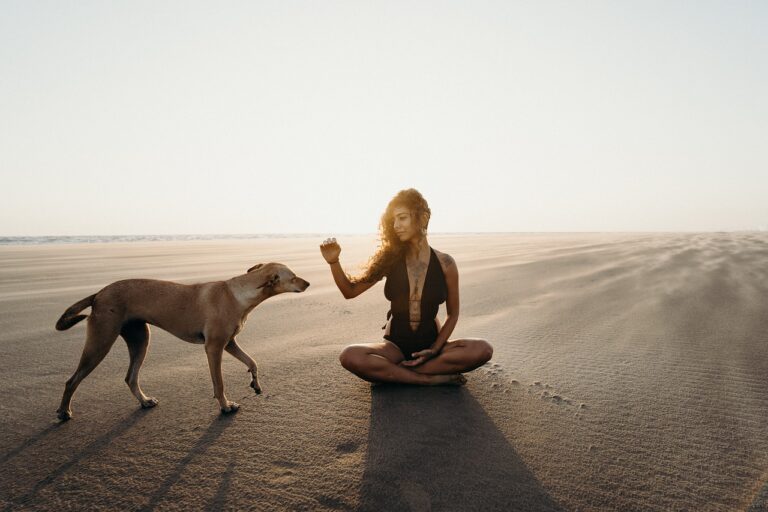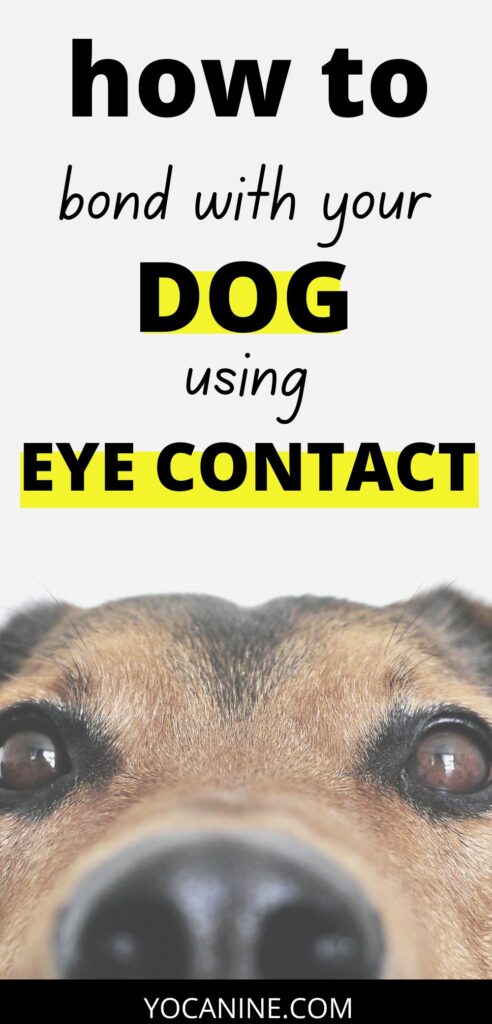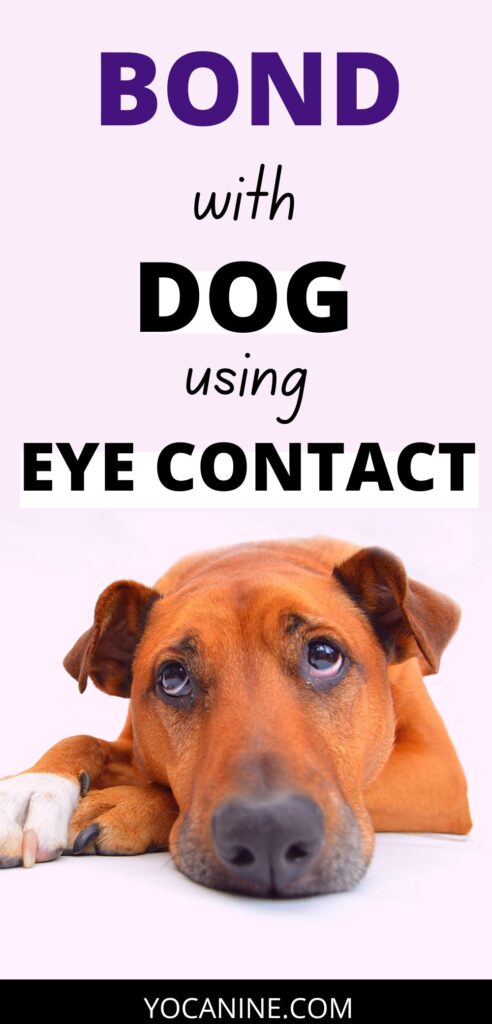
Every time I’m in the kitchen, my dog moves off the sofa and watches me.
Sometimes, I’m not dropping any crumbs and he falls asleep.
Other times, he senses my clumsiness and moves closer.
But most of the time… he just lovingly gazes from afar but within viewing distance.
One day, I stared at him back, smiling at how cute his minor stalking watching was.
His tail wagged and he just stared back. He looked even happier.
Now, I make eye contact with him frequently. When he’s on the sofa beside me and I look at him. He looks back and wags his tail, without breaking contact.
I feel a special connection every time this happens. And it’s not just in my head.
Research has come to show that dogs also value eye contact. In fact, it increases a hormone that makes them feel love.
To learn how to bond with your dog using eye contact, keep reading.
Why Eye Contact with Your Dog is Important
Eye contact is important to people. We all know this. That’s why you commonly hear the phrase, “look me in the eye when I’m talking to you.”
We know that it’s also important to dogs. I mean, we’ve always known, right? But now, the research is catching up with our hearts. Check out these amazing findings.
Boosts Oxytocin
Oxytocin is known as the “love chemical” and it’s present in both humans and dogs. For example, when we hug someone, our bodies release oxytocin, which helps us bond.
One study shows that when our dogs gaze into our eyes–and we gaze back–we’re flooded with oxytocin. Researchers studied 30 canines and their caretakers. Among the mix were a Labrador Retriever, dachshund, toy poodle, boxer, German shepherd and more. They found that the more dog owners and canines shared gazes, the more concentrated bursts of oxytocin they both had.
So how much did oxytocin boost after a loving gaze? A shocking 130% for dogs and 300% for humans.
To put this into perspective, this doesn’t happen with every animal. When researchers compared management professionals gazing at wolves, the oxytocin boost didn’t happen.
“It’s an incredible finding that suggests that dogs have hijacked the human bonding system,” said Brian Hare, an expert on canine cognition.
Dogs Adapted To Us
We probably already intuitively know that looking at our dog makes some difference in our bonding. But why?
Since we’re two different species, you may question how our oxytocin boosts mimic each other. One reason is that dogs likely integrated themselves into the human world by using some of our behaviors to form bonds. In essence, they could have evolved to use eye contact in a similar way to us.
Dog “Eyebrows” Evolving To Be More Human-Like
One article titled,” Dogs’ Eyes Have Changed Since Humans Befriended Them”, summarizes how dogs’ faces have literally shifted to be more similar to ours. Unlike wolves, they have eyebrow muscles that can give them a variety of expressions. In one study, researchers set out to learn whether any behaviors caused an animal to adapt quicker after adoption. They experimented with many factors, but one stuck out: their eyebrow movement.
Interestingly, studies have also shown that humans like dogs humans prefer pets with infant-like facial features.
Another similarity to children, one expert says dogs “dove right into our society” and took on the role of an infant in many ways.
How to Bond with Your Dog Using Eye Contact

If you want to try a different way of bonding with your dog, use your eyes. It’s free, simple and barely takes any time. Here’s how.
Gaze Frequently
In the study we referenced above, researchers noticed that the more often humans and dogs stared at each other, the more concentrated oxytocin surges they experienced.
So, to take advantage of this, gaze at her a few times throughout the day. Instead of setting time aside, aim to stare at her at random points when you catch her looking at you. Smile and make a genuine effort to look into her eyes instead of walking past or acknowledging with a quick pat.
Intermittent Eye Contact
Another option is to intermittent gaze at your dog while you’re playing with or petting her. When you see her look at you, make an effort to make genuine eye contact for a few moments. Then go back to playing, petting and talking softly to her. This is a particularly good idea for dogs who dislike direct eye contact of any sort. Pups with past traumas or with aggressive behaviors might not take well to long gazes, so shorter ones can feel safer and be better for their oxytocin boost.
Connecting with your dog can happen in small moments or in many moments in one play session.
Breeds Make Eye Contact Differently
If you notice that your dog likes more or less eye contact compared to another dog, know that it’s natural. Besides personality traits, breeds make eye contact differently.
For example, ancient breeds, like Siberian Huskies, Border Collies, Labrador Retrievers and German Shepherds are less likely to use eye contact. Since their genetically more similar to wolves than other breeds, they share some of their traits. As we talked about above, although dogs experience an oxytocin boost from eye contact, wolves don’t.
Reading Dog Eye Contact
What does eye contact mean to dogs? As you make an effort to bond with your dog using eye contact, notice patterns in how her eyes move according to what she’s trying to communicate. Not every gaze at you means she wants to connect, so it’s good to learn the difference.
Eye contact can look slightly different for every dog, but if you pay attention, over time you’ll begin to notice patterns. For example, when my dog stares at me but then quickly shifts his eyes, he wants to play. If I used that moment to try to gaze at him, he’d pick up a toy and throw it in my face (it’s happened!).
Other times, your dog might stare to communicate distress, anxiety or a need. An example is a dog who anxiously stares at you while she waits by the door because he really, really has to pee.
A dog who’s watching your movements or following you around the home could want a connection. And the traditional “puppy dog eyes” are always a good sign that someone is in need of some love.
Don’t Overdo Eye Contact
Gazing into your dog’s eyes for longer periods or intermittently is a good practice that will make you both feel more loved and bonded together. But you don’t need that much starring to get the benefits, so don’t overdo it.
You don’t need to spend minutes staring at your dog. In fact, you shouldn’t because they could misread it as a threat or that they’ve done something wrong. They could get anxious or confused. Instead, lovingly gaze for a few seconds. Since we don’t do this with other human beings a lot, even 10 seconds can seem like a very long time. And it is for our dogs. When you catch your dog looking at you, you only need to take a few moments away from your day.
Don’t Gaze at “Stranger” Dogs
It’s important to know that all the benefits that come from gazing into a dog’s eyes happen when you know the dog. If you’ve never met them before or don’t know them that well, do not stare at them.
Staring directly into a dog’s eyes, especially for a long period of time, can also be a sign of dominance or threat. For example, this stare-down happens before two dogs get into a fight. So, the dog can easily confuse it as a bad thing rather than a good thing. instead of having their love hormone surge, they could become stressed, fearful, anxious or aggressive.
Even if you have met a dog a few times, this isn’t a good trick to try. Eye contact gazing is best used with your own dogs. If you have a pup that is new to you, wait to build a trusting bond before long gazes.
Summary: Making Eye Contact with a Dog to Bond
Making eye contact with your dog is a great way to bond. Research has proven that it significantly raises the oxytocin levels of both you and your canine baby. Since that’s known as the “love” hormone, it can help us bond and become closer.
To use eye contact to better connect with your dog, first make sure she doesn’t have any issues with loving gazes, such as anxiety or aggression. Some dogs don’t like stares, even when they’re well-intentioned. When you catch your dog staring at you, stare at her back for a few seconds. Do it genuinely and maybe even with a slight smile. You can also gaze at her intermittently during your play or petting sessions. Remember that eye contact gazes should only be used with pets who know you very well. Staring at a strange dog could signal a threat to them.
